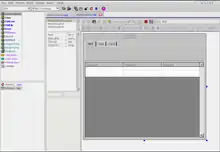Ultimate++
U++, formally known as Ultimate++ - is a C++ RAD framework that aims to reduce the code complexity of typical desktop applications by including all necessary toolkits into a single C++ framework. Programs created with it works on multiple Operating Systems and Hardware Architectures with performance without needing to write platform-specific code.
 TheIDE from 2010 | |
| Developer(s) | U++ team[1] |
|---|---|
| Initial release | 2004 |
| Stable release | 2023.2
/ 24 October 2023[2] |
| Repository | |
| Written in | C++ |
| Operating system | Unix/Linux/FreeBSD (X11), Windows, Windows CE, MacOS |
| Platform | Cross-platform |
| Type | Application framework |
| License | BSD license |
| Website | ultimatepp |
It possesses an Integrated Development Environment called TheIDE[3] that is designed to handle all library features.
Features
Some key features includes
- Includes an IDE with a GUI Designer
- Uses heavily RAII and auto pointers-like mechanisms to avoid manual memory management and could limit the use of pointers in the code [4]
- Can emulate[5] native widgets look and feel. On X11 systems, Ultimate++ supports GTK+ widgets look and feel.
- The standard distribution comes with U++ sources included.
- Uses NTL as a template system instead of STL.
- Supports databases, with libraries to connect with various database systems.
- Designed for high-performance application use cases with a low memory footprint and efficient use of system resources.
- Retains backward compatibility, allowing developers to upgrade to new versions of the framework without issues.
- Provides support for Unicode to make applications in multiple languages.
- Document editor,[6] Debugger, auto completion[7] and Icon Designer[8] for making tool icons with less effort.
- Possible to work with Android NDK and SDK[9]
- Web development and other features [10]
Supports
Operating system
- Windows
- GNU / Linux
- Unix-Like OS
- MacOS
Compilier / Port
- GCC
- Clang
- Visual C++
- MinGW
Database
- Microsoft SQL
- MySQL
- PostgreSQL
- Sqlite 3
Software built on U++
Example applications using U++ are:
- BEMRosetta[11] - hydrodynamic coefficients viewer and converter
- Openwind[12] - wind farm design software
- UppCAD[13] - multipurpose CAD system[14]
- WordNet Browser - browser for WordNet
See also
References
- "U++ team".
- "Release history".
- Getting started with Ultimate++ CodeProject article
- U++ Overview
- Chameleon examples
- "Topic++ :: U++".
- "Assist++ :: U++".
- "Icon Designer :: U++".
- "Android builder :: U++". www.ultimatepp.org. Retrieved 2023-05-29.
- "U++ Technologies :: U++". www.ultimatepp.org. Retrieved 2023-05-29.
- "U++ forum: Welcome to the forum". www.ultimatepp.org. Retrieved 2023-05-31.
- "Building OpenWind".
- "Ultimate++ Forums - UppCAD".
- "UppCAD".
Further reading
- "Ultimate++, l'ultime IDE pour le développement d'applications C++ multi-plates-formes". Programmez! (in French). 2014-02-05. Retrieved 2024-02-29.
- "Ultimate++ et les bases de données". Programmez! (in French). 2014-02-05. Retrieved 2024-02-29.
This article is issued from Wikipedia. The text is licensed under Creative Commons - Attribution - Sharealike. Additional terms may apply for the media files.